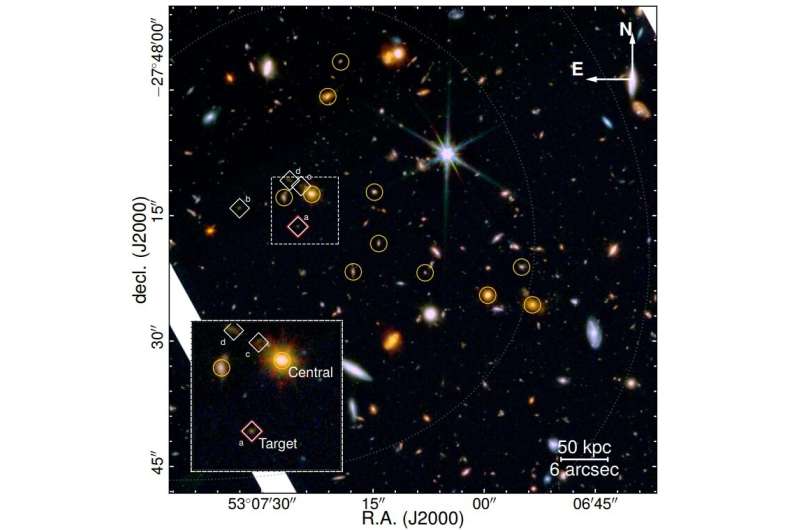July 25, 2023 report
This article has been reviewed according to Science X's editorial process and policies. Editors have highlighted the following attributes while ensuring the content's credibility:
fact-checked
preprint
trusted source
proofread
New low-mass quiescent galaxy discovered

By analyzing the data from the JWST Advanced Deep Extragalactic Survey (JADES), an international team of astronomers has discovered a new quiescent galaxy. The newfound system, designated JADES-GS+53.12365-27.80454, turns out to be the least massive quiescent galaxy detected so far at a high redshift. The discovery was detailed in a paper published July 17 on the preprint server arXiv.
Massive galaxies that stopped forming stars (known as massive quiescent galaxies) are plausible progenitors of giant elliptical galaxies. Given that these objects formed stars earlier and assembled their stellar masses more quickly, they could be key to improving our understanding of the process of galaxy evolution.
Now, a group of astronomers led by Lester Sandles of the University of Cambridge, U.K., reports the finding of a new quiescent galaxy. The discovery was made using the James Webb Space Telescope (JWST) as part of the JADES survey.
"We have presented deep JWST/NIRCam and NIRSpec observations of JADES-GS+53.12365-27.80454, a compact quiescent galaxy at z = 2.34, identified through its spectral break at 1.25 µm and the absence of emission lines," the researchers wrote in the paper.
The observations found that JADES-GS+53.12365-27.80454 has a stellar mass of only 950 million solar masses, which makes it the least massive high-redshift quiescent galaxy known to date. The galaxy has been quiescent for 600 million years, and its mass-weighted average stellar age is estimated to be between 0.8 and 1.7 billion years.
The results show that JADES-GS+53.12365-27.80454 has a different structure than more massive galaxies at similar redshift, suggesting a different evolutionary path. The astronomers estimate that the star-formation history of this galaxy peaked some 500 million to 1 billion years prior to the observational campaign.
The study also identified an overdensity of galaxies near JADES-GS+53.12365-27.80454, containing three spectroscopically confirmed, massive and old galaxies. One of these three massive systems lies at the center of the overdensity and only 4 arcseconds in projection from JADES-GS+53.12365-27.80454.
According to the authors of the paper, this finding, together with the point-spread function-matched photometry showcasing an inverse color gradient with radius, indicates an environment-driven quenching of JADES-GS+53.12365-27.80454.
"This suggests the low-mass galaxy was quenched by environment, making it possibly the earliest evidence for environment-driven quenching to date," the researchers concluded.
They added that further investigation of JADES-GS+53.12365-27.80454 should be conducted using ground-based surveys like the MOONS Redshift-Intensive Survey Experiment (MOON-RISE) and targeted surveys with JWST, in order to better characterize the quenching of this and other similar galaxies by environment.
More information: Lester Sandles et al, JADES: deep spectroscopy of a low-mass galaxy at redshift 2.3 quenched by environment, arXiv (2023). DOI: 10.48550/arxiv.2307.08633
Journal information: arXiv
© 2023 Science X Network



















